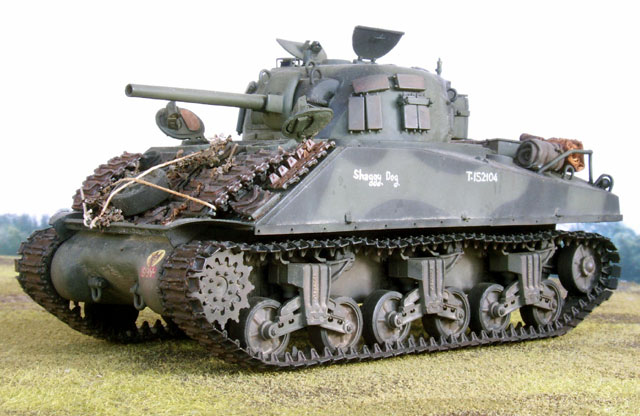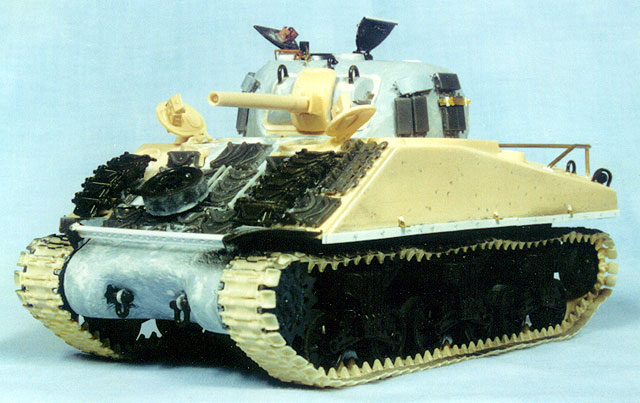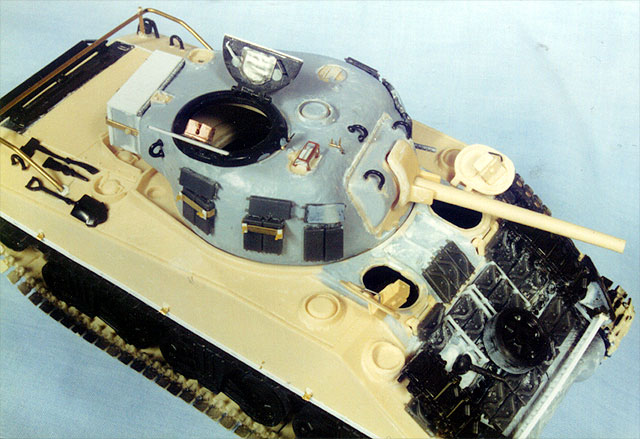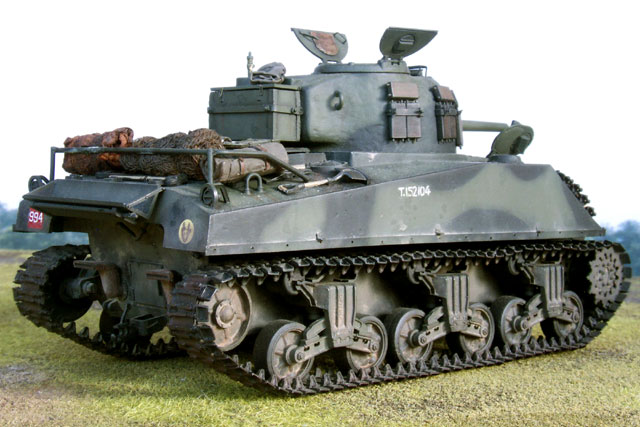Building the
"Universal Tank"
Sherman I
By Brett T. Green


Tamiya's 1/35
scale M4 Sherman is available online from
Squadron.com
When I first wrote this article in 1994, there was no way to build a 1/35
scale Sherman I (M4) straight from the box. Shortly after I finished this
conversion, Tamiya released their new 1/35 scale M4 Sherman which, with the
exception of stowage and some minor details, did a very good job of depicting
the British Sherman I. To add to my frustration, I found out recently that this
vehicle was not a Sherman I at all, but a Sherman II (M4A2)!
Although the conversion is no longer necessary, I trust that some of the
techniques might still be of interest!
The M4 Sherman is both a much loved and much maligned vehicle.
It has often been criticised for its high profile silhouette; its
inability to penetrate the armour of German heavy tanks at anything greater
than point blank range; its armour's vulnerability to high velocity guns;
and its rather disturbing tendency to explode in flames when penetrated. On
a vehicle-versus-vehicle basis, the Sherman was barely a match for a later
model Panzer IV. It was totally outclassed by the Panther, Tiger and late
war German Jagdpanzers and Sturmgeschutz. Its greatest strength was
quantity. Allied standardisation of this reliable design meant that
production facilities were not diverted from their main tasks by constantly
re-tooling and debugging new designs. Combined with an almost unlimited
supply line, total air superiority in Western Europe and a US industrial
manufacturing base uninterrupted by the direct effects of war, the Sherman
was deployed in such vast numbers as to be an effective weapon despite its
shortcomings.
In the period leading up to the Second World War, Great Britain had
developed a craftsman-like tradition of building Armoured Fighting
Vehicles. Rather than being mass-produced on automated factory lines,
British tanks were painstakingly hand finished. This slowed production
considerably. Also, British tanks were consistently one or two steps behind
their German counterparts, and tended to have long teething periods while
ironing out design and reliability problems. These problems eventually
proved fatal to most home grown British designs. The only British tank to
see service in Northern Europe in any quantity during 1944 was the
Churchill -- and even this was mainly used in the infantry support role.
The Cromwell, Challenger and the vastly superior Comet were used in fairly
limited numbers.
The bulk of the British armoured units in Europe were equipped with
Shermans. These consisted mainly of Mk. I (M4); the Mk. II (M4 Cast Hull);
the long-hulled Mk. V (M4A4) and a range of Firefly variants - mainly Mk.
Ic and Vc (see my
article on building an accurate Firefly Vc).
|
Building a
British Sherman |
I decided to build a Sherman Mk. I in service in France during late
1944. A photograph on page 46 of D-Day to Berlin provided my inspiration.
It shows a Sherman I finished in Khaki Drab with a disruptive Black
camouflage pattern. The vehicle has a number of interesting attributes,
including unusual extra armour; lots of stowage; early narrow mantlet; cast
transmission housing; foliage-assisted camouflage and three bar cleat
tracks with short duckbills.
I built this model during 1994 just before Dragon and Tamiya commenced
their Shermanfest -- chalk up another one to Murphy's Law of Modelling!
The simplest option for building a Sherman Mk. I at this time was to buy
the Kirin resin conversion. This conversion included a new upper hull,
turret with a choice of early narrow or later wide mantlet, hatches, scopes
and direct vision covers. I used the Tamiya M4A3 kit as the donor kit for
the lower hull, suspension and fittings. Of course, the best way to build a
Sherman I today is to buy the new Tamiya M4 kit.

Unless you happen to have the old Tamiya kit and the Kirin conversion in
your collection; plus the overwhelming urge to inhale some resin dust; you
probably won't be terribly interested in how this conversion slaps
together; however, some of the modifications and improvements may be of
interest to modellers building a British Sherman based on the new Tamiya
kit.
Lower Hull and
Suspension
The new Tamiya kit offers the choice of the bolted or cast transmission
cover. Both versions were seen on British Shermans, but my vehicle required
the cast nose (fortunately this was the part included in the older M4A3
kit). Tamiya's new Sherman sources a number of parts from the older M4A3
kit including the suspension units. These stand up quite well by today's
standards, with fine detail including casting numbers moulded on the units.
The only real problem is that they are not articulated. If you want to
model your Sherman tackling some challenging terrain, you will have to swap
the suspension units from an Italeri or Dragon kit.
It should also be noted that the trailing return roller mount is of the
later, up-swept type. Check your references carefully to see if the vehicle
you are modelling uses this type, or the horizontal mount often seen on
early-to-mid production Shermans. Conveniently, my reference photo was
unclear enough for me to assume the mounts were as per the kit. The only
mainstream kit that contains the horizontal trailing return roller mount is
the above-mentioned Dragon M4A1. The new Tamiya kit also offers the choice
of the open-webbed pattern or solid drive sprocket; and either solid or
spoked roadwheels. Check your references carefully.
I built the lower hull and suspension as per kit instructions. I did not
realise for some time that the rear hull and exhaust arrangement used on
the M4A3 was totally inappropriate for the Mk. I Sherman. If you are using
the new Tamiya M4 kit, you will not encounter this problem.
Upper Hull
I made a number of improvements to the upper hull. I started by lightly
pitting the surface of the resin using my motor tool and a small, round
headed bit. I then added sandskirt mounting strips to the lower edge of the
upper hull. I used .010" × .080" Evergreen brand styrene strip for this
job. Before gluing the strips to the side, I drilled out mounting holes at
regular intervals using a pin vice. My reference vehicle had three pieces
of small, right-angled metal welded above the sandshield mounts. I bent
these from .060" wide brass strip, and super-glued them in place. I assumed
that they were also on the opposite side.

The next task was to fabricate the stowage rack on the rear upper hull.
This was bent from .050" brass rod. Mounting points were drilled in the
upper hull to accommodate the forward mounting points of the rack. The rack
was then super-glued in place and the rear, vertical mounts were finally
glued in place. I used Squadron White Putty to represent weld beads on the
stowage rack and the angle brackets.
Turret
I decided to add some extra texture to the Kirin resin turret. I
roughened up the surface with the motor tool, then blended the effect with
Gunze Mr. Surfacer. The new Tamiya kit does not offer the option of the
early narrow M34 mantlet, so you will have to raid the spares box or a
Dragon M4A1 if you want to build this variant.
I scratchbuilt a stowage box from styrene strip and card. Brass strip
was used to represent the mounting strap, and four Verlinden bolts secured
the box to the strap. Latches were bent from brass wire. Finally, after
super-gluing the box to the rear of the turret, I made a hinge by winding
fine electrical wire around a thin brass rod.

This particular vehicle carried spare tracks on mounts on the turret
sides, but also used track pads apparently stuck to the turret. I am truly
mystified how this was achieved. The track pads were rubber and therefore
couldn't be welded; but there are no visible means of support. Another
puzzle is that at least one of the track pads is actually bent to follow
the contour of the turret - I can't imagine how that was d a general
clutter of spare tracks and a roadwheel to the front of the vehicle. I
attached the driver and co-driver's hatches, which were detailed with
piano-wire handles. Finally, Tamiya tools and hull fittings were fixed to
the rear deck.
I sprayed the entire vehicle Tamiya Acrylic Flat Black. I then masked
off the areas which were destined to stay black in the camouflage scheme
with "Post-It Notes" cut to shape. I sprayed several shades of Tamiya Green
to achieve a patchy appearance so typical of vehicles in the field. After
removing the masking tape, I hand painted the details and added stowage to
the rear deck. Model ship rigging was used to represent rope on the forward
hull. I also added a couple of small sprigs of "military fern" for foliage.

Before final weathering, I hand painted the vehicle name and serial with
Tamiya acrylic paint. Other markings were a combination of Verlinden dry
transfers and hand painting. To complete the project, I applied a liberal
dusting of light coloured pastel chalk, interrupted by streaks and puddles
of thin black acrylic wash.
As mentioned earlier, I built this Sherman in 1994. Both the armour
modelling market and my modelling skills have moved on substantially in the
intervening three years. This conversion did not represent my finest
modelling hour, but it was an enjoyable project. For me, it represented an
important step in feeling confident about working with resin. I will
probably use some of these techniques and improvements again when I
eventually get around to building the new Tamiya M4. Or, on the other hand,
I may just get lazy and use the new Accurate Armour British Sherman Update
sets!
|
Updated
Resource Guide for British Sherman I |
If I were to build this vehicle today, there would be a broader range of
alternatives available for the base kit and improvements for me the choose
from. The following list is not intended to be totally comprehensive, but a
snapshot of helpful items:
- Basic Kit - Tamiya M4 Sherman Early Production (Item 35190)
- The only 1/35 scale M4 injection moulded kit today is Tamiya's 1995
release. Fortunately, it is pretty much up to the standards of their very
best offerings, despite the inclusion of some sprues from the earlier
M4A3 release.
- Early M34 Gun Mantlet
- This one is a bit harder. Raid the spares box, or use the narrow
mantlet in the Dragon M4A1 (Kit number 6048). If you don't have this kit,
it should be relatively simple to cut down the M34A1 mantlet cover
supplied in the Tamiya kit, and fill/reshape the mantlet base to the
correct profile. For reference, compare the drawing of the M4, 1943
production on page 9 of Squadron/Signal "Sherman in Action" with the
drawing of the mid-production version on page 7.
- Scope Guards, Tie-Downs etc.
- I used Verlinden's small but useful etched Sherman Super Detail Set
(Part No. VP0263); but there are a number of alternatives. Eduard's M4A3
set no. 35-061 is equally relevant to the earlier M4 variants, and
includes pre-perforated sandshield mounting strips. On-The-Mark-Models
produce an excellent M4 brass etched accessory set (Part No. 3502).
Armour Research Company has a small but useful fret with sandshield
mounts and a couple of different replacement fender types (ARC 1018).
Finally, the new Polish company Aber has a very complete (maybe too
complete) etched set comprising of several large brass frets.
Unfortunately, I do not have a stock number for this item. For general
tie-downs and casting numbers, Kendall Model Company produces two tiny
but very useful frets.
- Stowage Boxes etc.
- Verlinden produce a resin set which includes an appropriate
turret-mounted stowage box for those too shy to build from scratch. The
item number is 346. This set includes a variety of additional stowage and
ammo boxes, however, if your sanity is up to it, don't deny yourself the
masochistic pleasure of trying to scratchbuild a totally squared-up box
from sheet styrene!
- Tracks
- Boy, has the Track industry been booming over the last five years!
Dragon, Accurate Armour, Cromwell and Fruilmodellismo all produce Sherman
tracks in various flavours, but if you want a three bar cleat, with or
without Duckbills, Accurate Armour (resin lengths) and RPHS (individual
links) are your choices.
-
Sherman in Action by Bruce Culver,
Squadron/Signal Publications, 1977, Texas, USA. ISBN 0-89747-049-4
-
The Universal Tank - British Armour in
the Second World War Part 2 by David Fletcher, HMSO Publishing, 1993,
London. ISBN 0-11-290534-X
-
New Vanguard 3 "Sherman Medium Tank
1942-1945" by Steve Zaloga and Peter Sarson, Osprey Publishing
Limited, 1993, London. ISBN 185532 296 X
-
D-Day to Berlin by Terence Wise, Arms and
Armour Press, 1979, London ISBN 1-85409-212-X Photograph on Page 46
and Colour Artwork on Page 65.
|
Home
| What's New |
Features |
Gallery |
Reviews |
Reference |
Forum |
Search